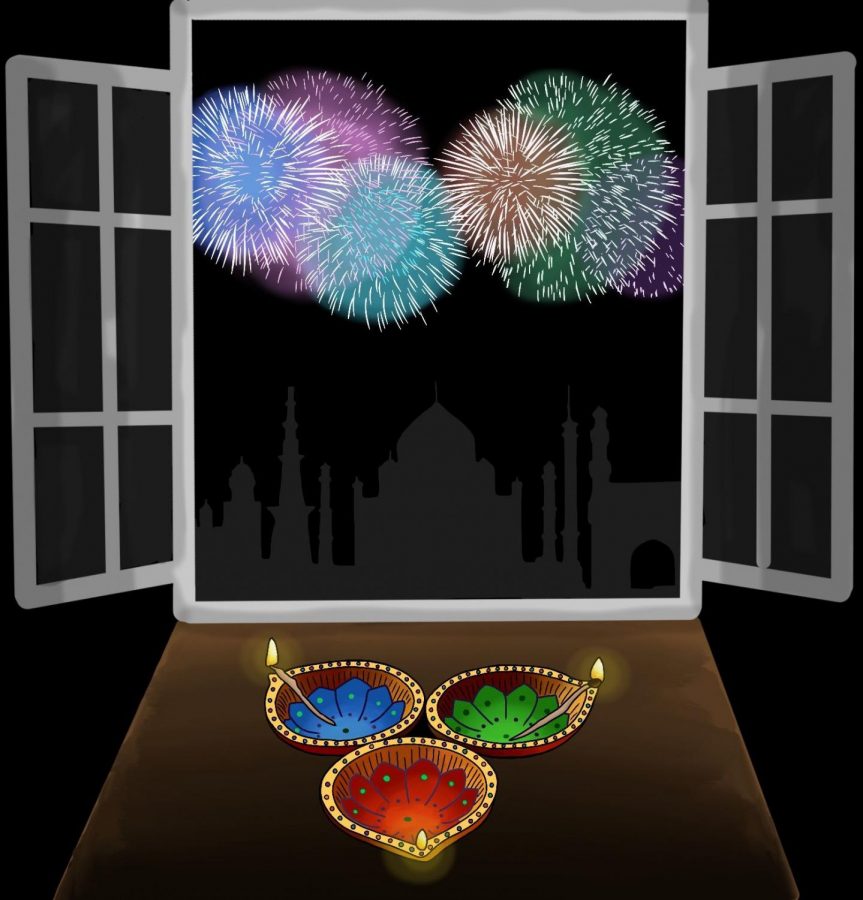Diwali: A History of the Indian Holiday and A Look Into How It Has Been Celebrated During the Pandemic
December 3, 2020
If every time I came home, there was a big celebration with lights and fireworks, I wouldn’t mind coming home more often. Just kidding–but many do come home and meet up with family and friends in order to celebrate one of the biggest festivals in India: Diwali, the Festival of Lights.
Diwali is one of the biggest celebrations in India, but different regions have various approaches to the festival and how they observe it.
In North India, Diwali marks the anniversary that Prince Rama, who was an incarnation of the god Vishnu, returned home from his exile and war with King Ravana. As Rama returned to his home in Ayodhya, citizens lit millions of lights to help him find his way home and welcome him back. Indians still light lamps, typically clay lamps called diyas, when observing Diwali.
In South India, Diwali celebrates the defeat of the tyrant king Narakasura at the hands of Lord Krishna, another incarnation of Vishnu, and his wife Sathyabama. After the battle, Krishna is said to have returned to his palace to wash off the blood and sins from the fight. It has become tradition for South Indians to wake up early and bathe in scented oils for this reason.
Although some stories of Diwali involve the god Vishnu, Indians typically worship Lakshmi, the goddess of wealth, and Ganesha, who is believed to be the remover of obstacles. It is believed that Lakshmi will visit houses on Diwali and bless them with prosperity.
In India, Diwali is a day for extended family to gather and celebrate together. Although it’s a traditional ceremony, people in India are devoted to their celebration of Diwali. So many fireworks are lit on Diwali that it is actually a major source of air pollution in the region.
On the other hand, celebrations in the United States are a lot more low-key.
Indian Americans like Sriya Pulavarthi, ‘22, celebrate Diwali with friends and their Indian community in the US rather than with their extended family, since they are often in India. Pulavarthi usually goes to her family friend’s house to light firecrackers and observe a pooja together, which is how Hindus worship their gods. She would also typically go to functions held by her local Telugu American Association.
Celebrations are generally less traditional, but that doesn’t stop Indian Americans from going all out. Houses are decked in lights and, of course, people bring sparklers and fireworks to share.
The current pandemic, however, has made it more difficult for Indian Americans to celebrate with their family, friends, and even in their workplaces.
Asha Baskaran, Director of Assets Protection at Target and Indian-born American who has lived half her life in India and the other half in America, has organized Diwali functions for her workplace as a member of the Asian Business Council there. Although in previous years the main pull was the delicious food provided by catering, Target’s most recent Diwali celebration was a one and a half hour immersion in Indian culture, with stations featuring aspects of Diwali and Indian culture such as diya decoration, traditional dances like Garba or Bhangra, Indian fashion and henna.
The pandemic caused Baskaran and the rest of the Asian Business Council had to rethink their entire Diwali function, however, and they came up with a plan to feature Diwali and Indian culture virtually.
Rather than celebrating the festival on one day, the celebrations were spread out over the week, and each day featured a different topic. A PowerPoint presentation was planned for one day, with a reported attendance of about 250 people–an impressive number considering there wouldn’t be catered food.
Another day of Target’s Diwali celebration featured Zumba with a Bollywood twist. To make sure people were engaged throughout the week, Baskaran and her colleagues came up with an idea for participants to submit photos of their participation for a chance to win raffle prizes.
Diwali is a time to come together and celebrate, and Indians have come up with inventive ways to continue celebrating their culture and the festival even in the face of the pandemic.






























